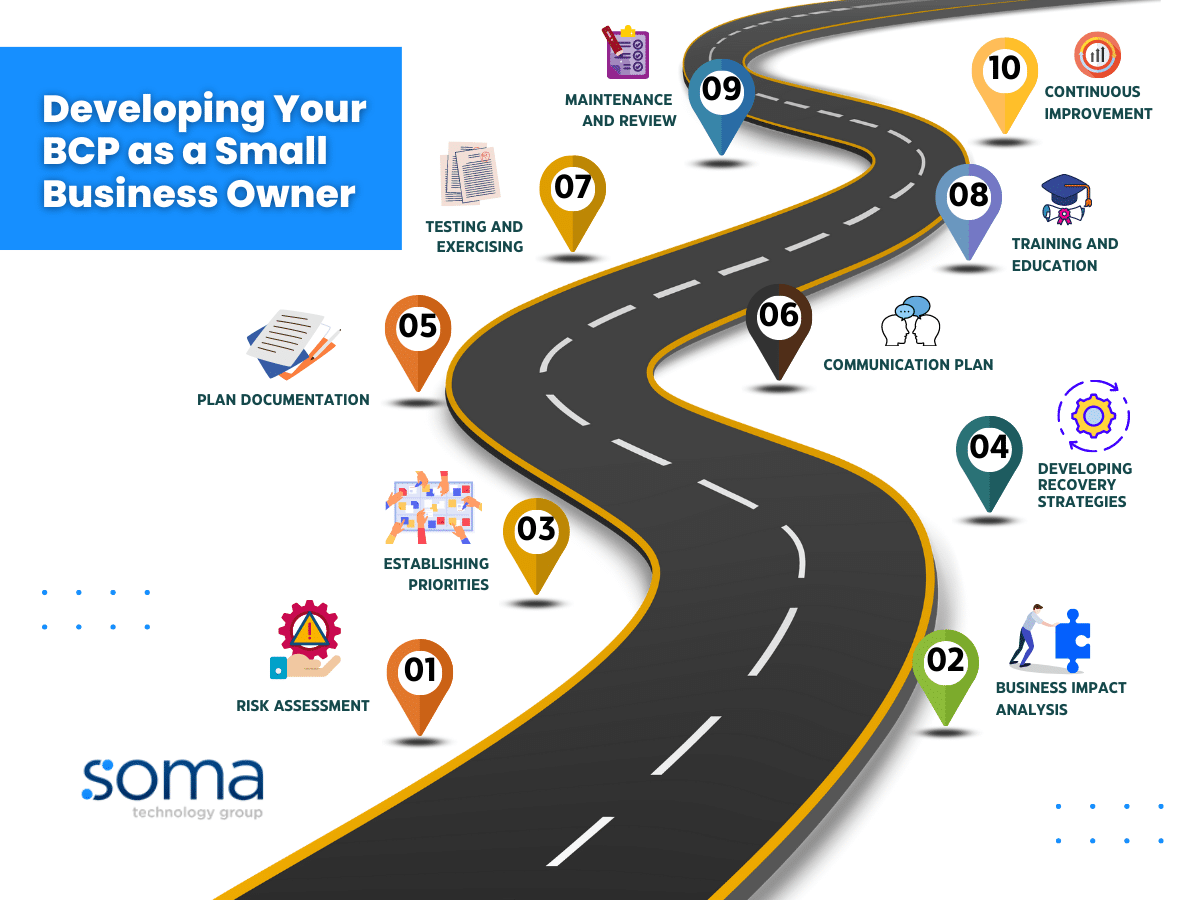In today’s fast-paced and unpredictable business landscape, ensuring the continuity of operations is crucial for the success and survival of any small business. Unexpected events, such as natural disasters, cyber-attacks, or a global pandemic, can disrupt normal operations and have severe consequences if not handled properly. To safeguard your small business against these potential threats, it is essential to have a comprehensive Business Continuity Plan (BCP) in place.
This article will discuss a 10-step guide to creating a BCP for your small business. So, whether you are just starting your business or have been running it for years, this guide will empower you to navigate through challenging times and emerge stronger.
What is a Business Continuity Plan, and Why is it important?
A business continuity plan or BCP is a comprehensive strategy that outlines the procedures and protocols of a company to be followed in the event of a disruption or crisis, such as natural disasters, cyber-attacks, or pandemics.
Usually, BCP aims to minimise these disruptions’ impact on critical business operations, mitigate risks, and facilitate a swift recovery. Likewise, a well-designed BCP encompasses various aspects of an organisation’s operations, including IT systems, communication channels, human resources, finance, and customer service.
It should also involve identifying threats and vulnerabilities, assessing their impact on critical functions and processes, and developing strategies to maintain essential operations during adverse circumstances. In addition, a good BCP should provide clear guidelines on responding effectively during emergencies by establishing alternative work arrangements and implementing backup systems and data recovery protocols.
Why is having a BCP important for small businesses?
As mentioned, the primary purpose of BCP is to minimise the impact of disruption that can affect small businesses. Implementing a BCP helps organisations navigate through crises and enhances their overall resilience. It demonstrates proactive risk management practices which can instil confidence in stakeholders such as employees, customers, investors, and regulatory authorities.
Moreover, a BCP can significantly reduce downtime and financial losses associated with disruptions while ensuring uninterrupted service delivery.
Likewise, a business continuity plan (BCP) is crucial for small businesses due to several reasons:
- Minimising Financial Impact. Disruptions can result in significant financial losses for small businesses. In fact, according to Datto, an hour of downtime can cost more than $10,000 for small businesses. But with BCP, companies can prevent this disruption, identify critical functions and processes that may be affected during downtime.
- Protecting Reputation and Customer Confidence. Small businesses rely heavily on their reputation and customer loyalty. Failing to respond adequately to disruptions can damage trust and confidence in the company. With a BCP, small business owners can demonstrate their commitment to continuity, reassuring customers, and stakeholders that they are trained to handle unexpected events.
- Meeting Regulatory and Legal Requirements. Some industries and jurisdictions have specific requirements regarding business continuity planning. Compliance with these regulations is essential for small businesses to avoid penalties or legal issues.
- Safeguarding Employees and Stakeholders. A Business continuity plan for small businesses includes techniques for safeguarding the well-being of employees and stakeholders during a crisis. Clear protocols can help small enterprises protect their workforce, demonstrate a duty of care, and maintain employee morale.
- Enhancing Business Resilience. A BCP enables small businesses to build resilience by identifying vulnerabilities, developing recovery strategies, and implementing proactive measures. By proactively addressing potential risks, companies can become more adaptable, agile, and better equipped to handle future challenges.
How to Develop Your BCP as a Small Business Owner?
Now that you know the benefits of BCP, it’s time to develop one for your company. As a small business owner, developing a robust business continuity plan is vital for ensuring the survival and success of your venture.
Here is a step-by-step guide to creating the ideal BCP to help you navigate uncertainties and protect your business from potential disruptions.

Step 1: Risk Assessment
In today’s rapidly changing business landscape, businesses face numerous challenges that can disrupt operations. To mitigate these challenges, entrepreneurs must include a risk assessment in their business continuity plan for small businesses.
But what really is risk assessment? Risk assessment identifies, analyses, and evaluates potential risks that could impact an organisation’s ability to function. It involves evaluating the probability and potential impact of various events or scenarios in the company. The purpose of risk assessment in a business continuity plan is to prioritise risks based on their severity and likelihood of occurrence.
As such, during the risk assessment process, small business owners must facilitate a thorough analysis of their internal and external environments, including existing control measures, vulnerabilities in critical functions, and regulatory or compliance requirements.
Step 2: Business Impact Analysis
Business impact analysis (BIA) plays a crucial role in developing a comprehensive Business continuity plan for small businesses. It involves assessing and identifying the potential impacts of various disruptions on an organisation’s critical business functions and processes.
The primary goal of BIA is to quantify potential financial, regulatory, operational, and reputational impacts that could arise during a disruption. As such, it enables business owners to understand which activities are critical for their survival and prioritise them accordingly.
Moreover, a BIA provides organisations with the necessary information to develop strategies for minimising downtime, implementing effective recovery measures, and allocating resources efficiently.
Step 3: Establishing Priorities
Once you know the risks and impacts that business disruptions can bring you, it’s time to establish priorities. Having a well-defined priority in your business continuity plan is crucial. Organisations can now allocate resources and focus on the most critical areas, minimising potential risks and maximising their ability to recover swiftly.
To start, consolidate all the risks and impacts you identified on the previous steps, identify the most susceptible to disruption, and prioritise them accordingly. Remember to also consider external and internal factors that could impact the organisation’s ability to effectively operate, such as key personnel, technology, market conditions, supply chain, etc.
Next, establish clear guidelines for resource allocation during an incident or crisis situation. This involves defining roles and responsibilities within the organisation’s incident response or emergency management teams. Each priority should have assigned resources dedicated to its protection and recovery.
Step 4: Developing Recovery Strategies
Another essential component of BCP is a business recovery plan. This is a crucial aspect as it minimises disruptions’ impact and ensures that the business can bounce back quickly.
Developing recovery strategies requires careful analysis and planning. It involves identifying potential risks and vulnerabilities, assessing their impact on operations, and determining the most appropriate actions to mitigate them.
One key consideration when developing recovery strategies is prioritisation. Not all disruptions will have the same level of impact on business operations. Therefore, it is crucial to prioritise critical functions or processes that are essential for maintaining core operations or meeting customer needs.
Another critical aspect to consider is communication. During times of crisis, clear and effective communication becomes paramount. Organisations must establish channels for internal communication among employees and external communication with stakeholders such as customers, suppliers, and partners.
Step 5: Documentation Plan
The following key component of the business continuity plan for small businesses is the documentation plan. The documentation plan serves as a roadmap for capturing and organising essential data related to the organisation’s operations, infrastructure, resources, and dependencies.
This document outlines the systematic approach to documenting critical processes, procedures, and information necessary for effective response and recovery. In addition, it should include various aspects of the BCP, including risk assessments, incident response protocols, communication strategies, and recovery procedures.
Step 6: Communication Plan
As part of a broader business continuity plan, a communication plan outlines the strategies and protocols for effective communication within the organisation and with external parties. It is a roadmap for effectively disseminating information during a crisis or disruption.
The primary goal of a communication plan in a business continuity context is to establish clear channels and protocols for internal and external communication. As such, it should outline how key stakeholders, including employees, customers, or suppliers, will be kept informed and updated during an emergency or significant event that may impact normal operations.
For small businesses, having a clear communication plan is especially important as they often have limited resources and may face unique challenges during times of crisis. Small companies can minimise confusion, maintain transparency, and ensure the timely flow of information to employees, customers, suppliers, and other relevant stakeholders by having a well-thought-out communication plan. This makes it an essential component of BCP for small businesses.
Step 7: Testing and Exercising
Once you have combined all components from the previous elements, it’s time to put them to the test! It is essential to regularly test and exercise your business continuity plan for small businesses to ensure its effectiveness and identify gaps for improvements.
In addition, testing and exercising your BCP will allow you to simulate different scenarios and evaluate your small business’ preparedness. By doing so, you can identify potential weaknesses and make necessary adjustments before the crisis occurs.
Step 8: Training and Education
Another critical aspect of a small business continuity plan is training and education. This is necessary to ensure that your employees and other stakeholders are well-prepared to implement your plan and continue operations during a crisis.
As such, this equips them with the knowledge and skills necessary to respond quickly and mitigate potential losses. Moreover, small businesses can empower employees to understand their roles and responsibilities during emergencies and implement the protocols to maintain critical functions. This enhances overall preparedness and boosts employee confidence and morale in times of uncertainty.
Furthermore, training allows small businesses to test their business continuity plan through simulations or drills. These exercises enable employees to practice their response strategies in a controlled environment, identifying gaps or areas for improvement before a crisis occurs. Regular training sessions also ensure that employees stay up to date with evolving threats and best practices in business continuity management.
Step 9: Maintenance and Review
The next step to creating the perfect BCP for small businesses is maintenance and review. Regularly reviewing your business continuity plan allows you to identify any gaps or weaknesses that may have arisen due to organisational or external changes.
Likewise, to maintain your BCP, you should keep up to date with the latest information about your business, such as the contact of key personnel, suppliers, and other stakeholders. Regularly updating this information ensures that everyone involved in the execution of the plan can be reached promptly during an emergency.
Step 10: Continuous Improvement
And that’s it. You probably have the perfect plan for your small business at this step. However, it doesn’t end there. The market and your industry constantly change with new trends and technologies being introduced daily. So, make sure to review and improve your business continuity plan continuously.
You can also take the next step in continuously improving your business continuity plan and ensuring the resilience of your operations. Avail SOMA’s expert IT advisory and consulting services to enhance your existing project, identify areas for improvement, and implement robust strategies. Contact us today to schedule a consultation and unlock the full potential of your business continuity efforts. We will fortify your business against disruptions and secure a prosperous future.



